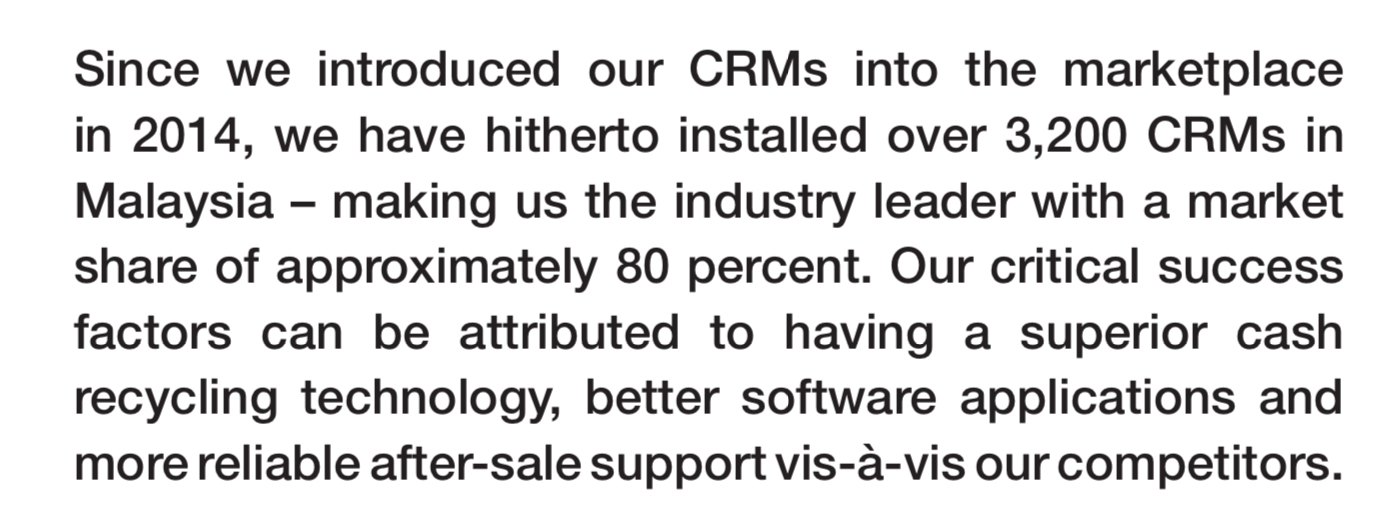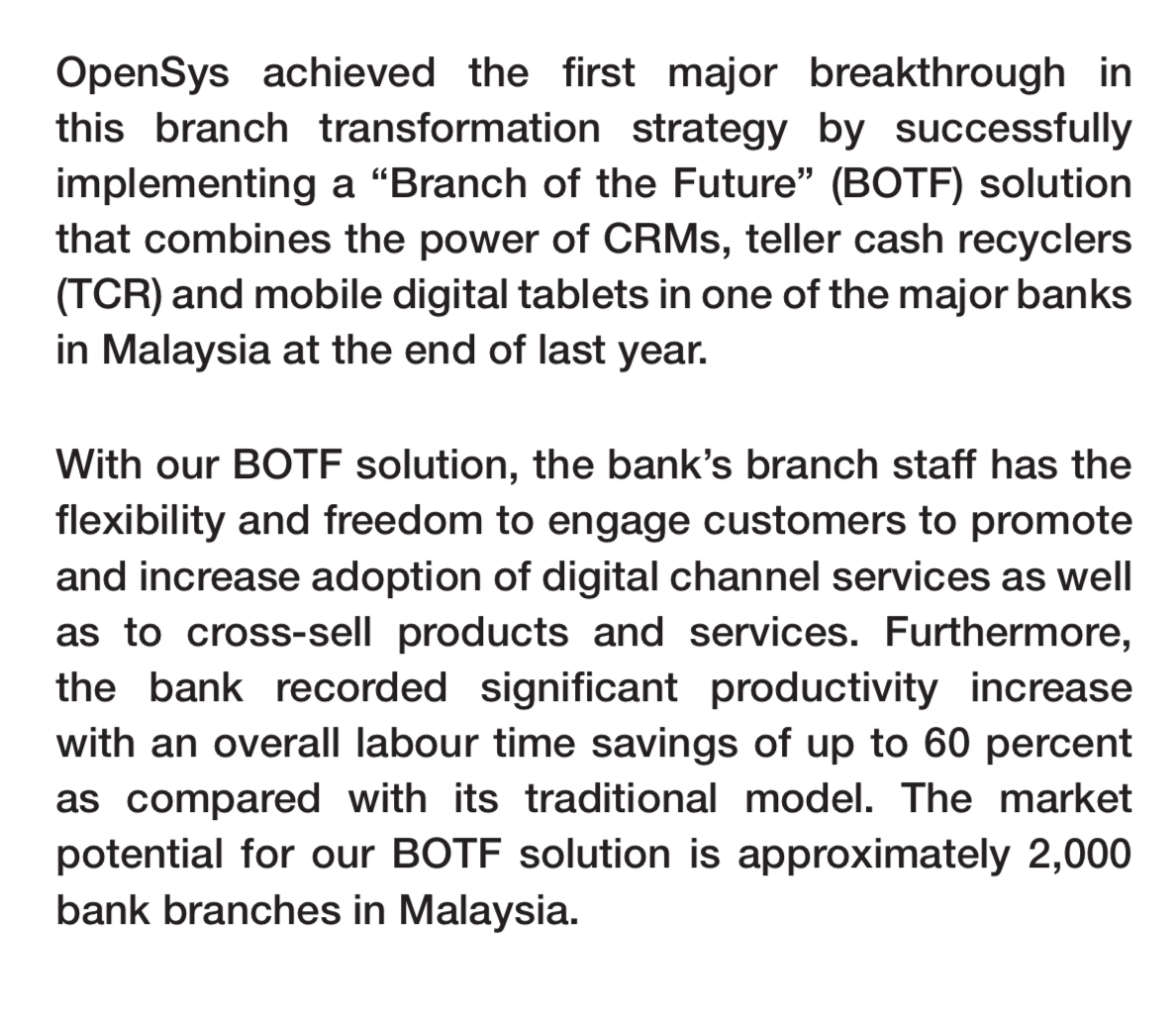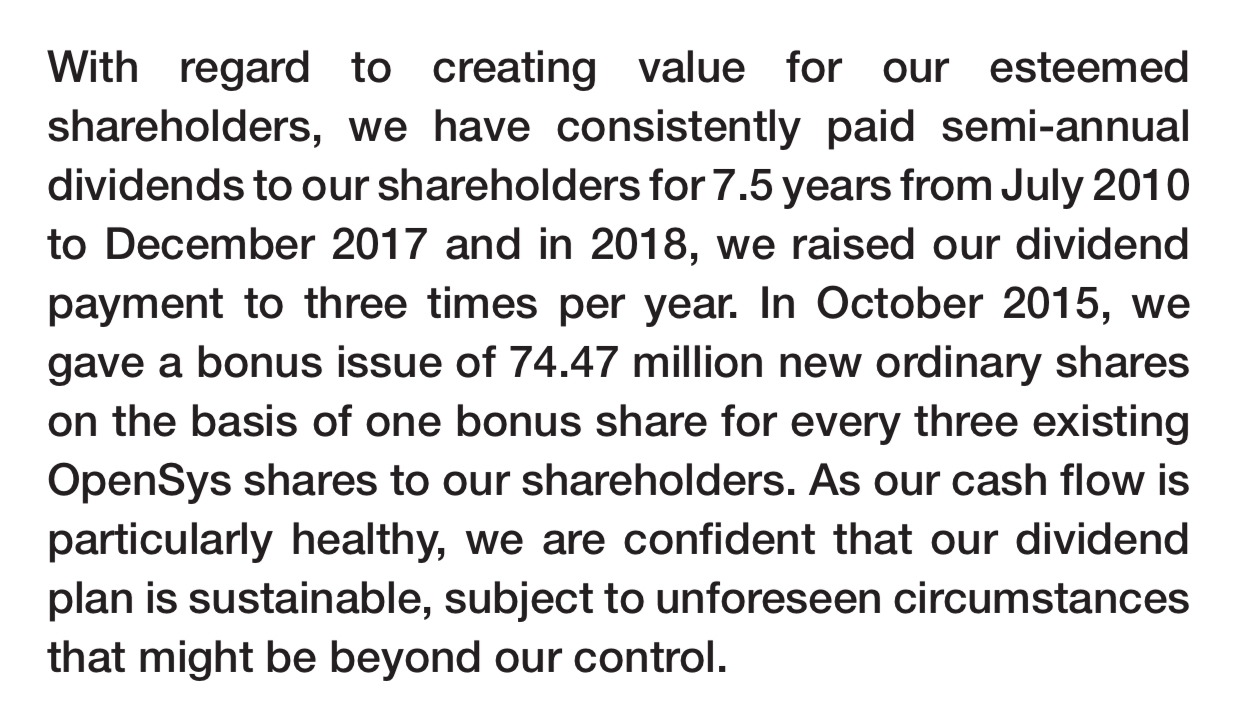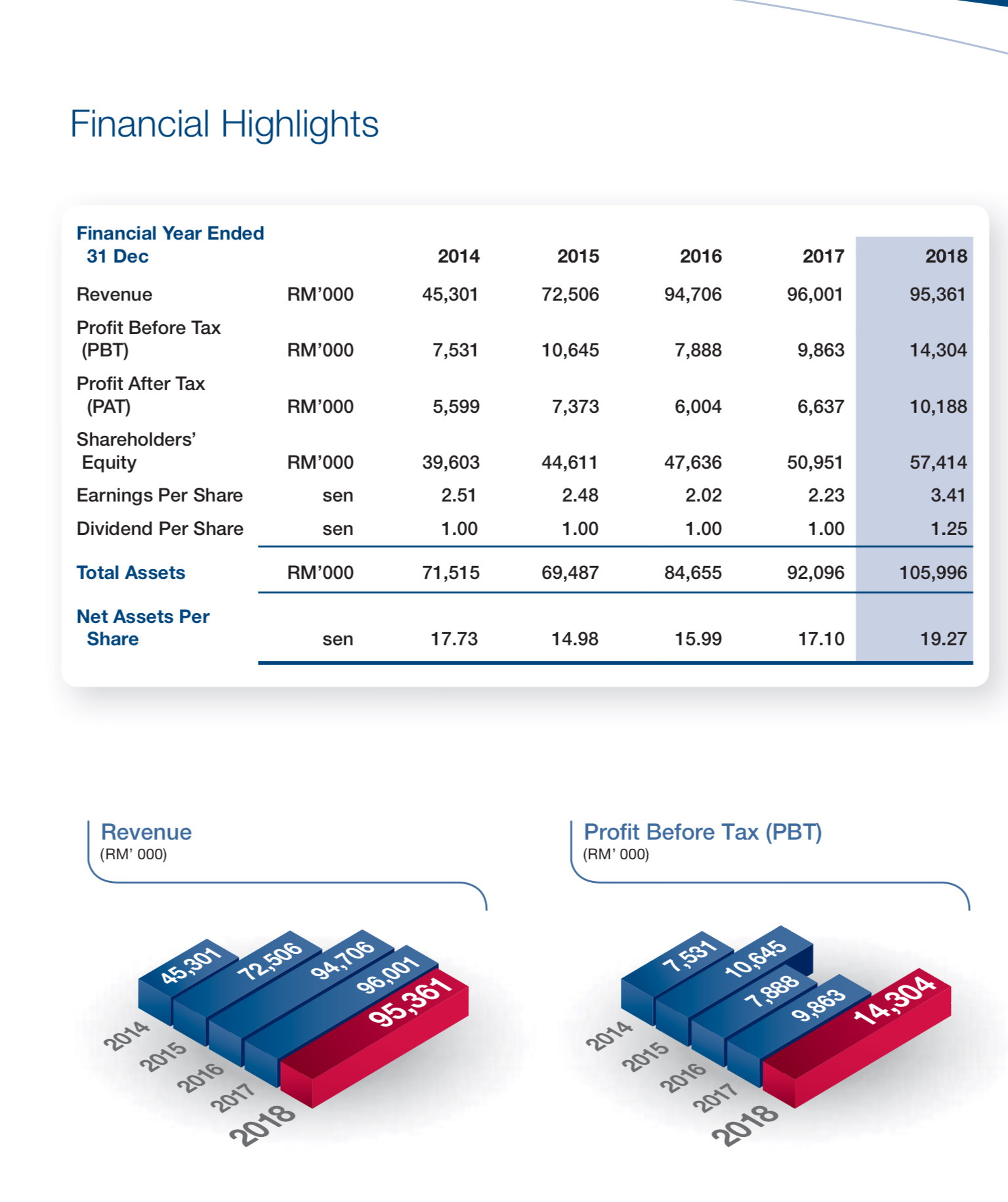This is probably the best “Management Discussion & Analysis” in the ACE market. Management zooms in on the most important question that investors had in their mind. First thing first.
There were a number of developments at OpenSys in 2018. OpenSys pioneered the ATM Smart Client concept with a major bank in Malaysia...resulting in additional revenue and profit to the bank.
Demand for CRMs continued to grow. Since Opensys introduced its CRMs into the marketplace in 2014, it had installed over 3,200 CRMs in Malaysia vs. 2,500 in 2017.
A new source of revenue. OpenSys achieved the first major breakthrough in branch transformation strategy by successfully implementing a “Branch of the Future” (BOTF) solution. The market potential for its BOTF solution is approximately 2,000 bank branches in Malaysia.
Extracted from the Annual Report of OpenSys:

Is cash going the way of the dinosaurs?
In June 2018, Cardtronics partnered with
Edelman Intelligence, an independent market research company, to conduct
a 20-minute, online survey among a nationally representative sample of
n=1,000 U.S. adults aged 18 years and above.
Respondents were asked about their
in-person (not online) payment preferences and habits either in brick-
and-mortar stores or with other individuals, with results occasionally
being split into groups based on what payment methods were used.
Throughout the survey, separate questions were asked about mobile
wallets, store-specific apps, bank peer-to-peer (P2P) apps and non-bank
P2P apps.
The survey reveals that, in spite of
advances in digital and mobile payment technology, cash maintains its
place as a pillar of payments and a top choice for consumers. The fact
is, cash matters. 73 percent of consumers used cash regularly despite
more payment methods being available – which is true among both urban
(78 percent) and rural residents (72 percent).
Additionally, 94 percent of urban
residents and 93 percent of rural residents like having the ability to
use a variety of payment methods that includes cash. 64 percent of
respondents feel nervous when they do not have cash on them or in their
wallet. 56 percent of respondents are more likely to go to a store that
only accepts cash than a store that does not accept cash at all (44
percent). Almost half (45 percent) would likely stop going to a store or
restaurant they like if it stopped accepting cash completely.
While new mobile payment options
continue to pop up with regularity, mobile payments were never favored
by more than 10 percent of respondents for any retail payment situation
surveyed. In fact, 90 percent of respondents think cash is safe to use
and 95 percent think it is more reliable.
Talking about the reliability of cash, it
is worth pondering what happens in scenarios where electronic or
digital monies are the only accepted form of payment in the event of
computer system downtime or natural disasters.
In October 2018, a cashless restaurant in Hollywood suffered a payment system crash – forcing the store to give away free lunches for everyone
in line. Ironically, the lunch queue that day would probably have gone
quicker for that crowd had the restaurant accepted cash. Now, imagine a
similar crash, but on a bigger scale, if WeChat or Ali Pay went down for
several days in China?
In December last year, a strong
earthquake in Japan’s Hokkaido island triggered a large-scale power
outage and Sapporo City instantly became a dark capital. During this
period, 1.95 million residents flocked to supermarkets and convenience
stores to buy life supplies. Unfortunately, some of the victims who
usually use their mobile phones to make payments, could not buy what
they needed because they did not carry cash.
Due to the importance of cash in most
societies around the world, the ubiquitous automated teller machine
(ATM) is still as relevant as ever. It is consistently ranked as the No.
1 self-service channel and interactive touchpoint with a bank, even
among millennials and smartphone users. From its inaugural installation
at Barclays Bank in North London in June 1967, the ATM can now be found
everywhere – from the most modern cities to the loneliest outposts,
including a mountaintop in the Himalayas.
As the number of ATM increases, they
have also stepped up in sophistication to keep up with modern times.
Today’s ATMs are a far cry from that first installed ATM at Barclays
Bank. In addition to dispensing cash, today’s advanced machines can
accept cash and cheques; issue prepaid cards, stamps and lottery
tickets; grant loans and take payments of almost any kind; calculate and
convert one nation’s currency into another; remit money to a relative
halfway around the world and most impressively, perform these functions
with better than 99 percent reliability.
In the foreseeable future, ATMs will
continue to evolve and remain relevant by adopting mobile technologies
to cater to millenials and Gen Z. There are already ATMs today that
allow customers to perform cardless ATM withdrawals using their mobile
phones. Soon, customers will be able to sign into ATMs using their
fingerprints, pictures of eyes or faces, or voice recognition that are
stored on their mobile phones, which will then transmit a code to the
ATMs to do the necessary banking transactions.
In 2018, OpenSys pioneered the ATM
Smart Client concept with a major bank in Malaysia. ATM Smart Client is a
web user interface that mimics the look, feel and usability of an
Android or IOS tablet on an ATM screen without making any
infrastructural change to the bank’s ATM software environment. Our ATM
Smart Client allows customers to perform all their frequent transactions
within a personalized main screen thus creating an enriched customer
experience with a modernized look and feel. Its intuitive user interface
enables the bank to engage personalized sales and marketing activities
with the customers at the point of transaction, resulting in additional
revenue and profit to the bank.
Considering the advances in ATM
technology, it would not be inaccurate to view the ATM as the original
“Fintech” disruptor. Before ATMs, the banks were very traditional and
dependent on a lot of human resource to operate. After the advent of the
ATM, the banks could re-deploy their human resources more efficiently
to assist and educate customers on the banks’ products and services thus
increasing the banks’ profit. With the implementation of ATM Smart
Client, OpenSys has taken the technology a step further by leveraging
the ATM as the bridge between the digital and non-digital delivery
channels of the banks.
OpenSys technology partner in the CRM
market is OKI Electric Japan. OKI invented and pioneered the use of cash
recycling technology about thirty-seven years’ ago in 1982. Due to its
first mover advantage, OKI is currently one of the leading suppliers of
CRMs in Japan, China, India, Indonesia, Russia, South Korea, Taiwan and
Brazil.

Since we introduced our CRMs into the
marketplace in 2014, we have hitherto installed over 3,200 CRMs in
Malaysia – making us the industry leader with a market share of
approximately 80 percent. Our critical success factors can be attributed
to having a superior cash recycling technology, better software
applications and more reliable after-sale support vis-à-vis our
competitors.
Currently, the total number of
self-service kiosks for banks in Malaysia is approximately 15,000 units
of ATMs, CDMs and CRMs and 3,000 units of cheque deposit machines. About
5 years’ ago, OpenSys catalysed the CRM market in Malaysia by
developing proprietary software codes to enable banks that have separate
computer mainframes for cash dispensing and cash deposits to use cash
recycling technology.
Due to the efforts of OpenSys, the
number of CRMs increased dramatically from a small installed base of
200-300 units in 2014 to more than 4,000 units at end 2018. Since then,
the CRM installed base continues to grow at the expense of ATMs and
CDMs. If the banks in Malaysia keep up the momentum of replacing their
older ATMs and CDMs with CRMs, OpenSys is in a prime position to profit
from it. Considering that we have an excellent track record in providing
the best customer experience, we are optimistic that we will continue
to win more market share than our competitors moving forward.
In addition to the growth of CRMs, it
is pertinent to note that an increasing number of banks are embarking on
a comprehensive branch transformation strategy to modernize their
traditional branch banking with digital banking – to cater to the needs
of millennials and Gen Z. The transformation of the traditional bank
branches into modern branches make use of self-serve privacy stations,
digital stations, self-service terminals and advanced technologies such
as artificial intelligence to better predict individual customer’s need
for services and products and to provide them with a better in- branch
experience.

OpenSys achieved the first major
breakthrough in this branch transformation strategy by successfully
implementing a “Branch of the Future” (BOTF) solution that combines the
power of CRMs, teller cash recyclers (TCR) and mobile digital tablets in
one of the major banks in Malaysia at the end of last year.
With our BOTF solution, the bank’s
branch staff has the flexibility and freedom to engage customers to
promote and increase adoption of digital channel services as well as to
cross-sell products and services. Furthermore, the bank recorded
significant productivity increase with an overall labour time savings of
up to 60 percent as compared with its traditional model. The market
potential for our BOTF solution is approximately 2,000 bank branches in
Malaysia.
Our outsourcing business in providing
bill payment kiosks to utility, insurance and telecommunication
companies continues to remain strong. Not unlike banks, these
institutions are transforming their branches to be leaner, friendlier
and more efficient by pushing mundane tasks to self-service kiosks. In
doing so, they can free up their valuable human resources to perform
more sales and marketing related activities with their customers. The companies that are currently using our bill payment kiosks are progressively installing more machines as time progresses.
We currently own 12,064 square feet of
office property at Pinnacle PJ and a three-storey shop office property
at Putra Heights with an estimated value of RM13.0 million and RM3.0
million respectively. The property at Pinnacle PJ is used as our
corporate headquarters whereas the property at Putra Heights is mainly
used for the staging and assembly of our CRMs, bill payment kiosks and
cheque deposit machines.

With regard to creating value for our
esteemed shareholders, we have consistently paid semi-annual dividends
to our shareholders for 7.5 years from July 2010 to December 2017 and in
2018, we raised our dividend payment to three times per year. In
October 2015, we gave a bonus issue of 74.47 million new ordinary shares
on the basis of one bonus share for every three existing OpenSys shares
to our shareholders. As our cash flow is particularly healthy, we are
confident that our dividend plan is sustainable, subject to unforeseen
circumstances that might be beyond our control.
The Board of Directors would like take
this opportunity to extend our gratitude and appreciation to our
shareholders, customers, suppliers and business partners for the
invaluable support that you give to OpenSys.
We would also like to thank each and
every member of our management and staff for their dedication and
commitment to grow with our Company, without which our success would not
be possible.


Source
Annual report 2018
